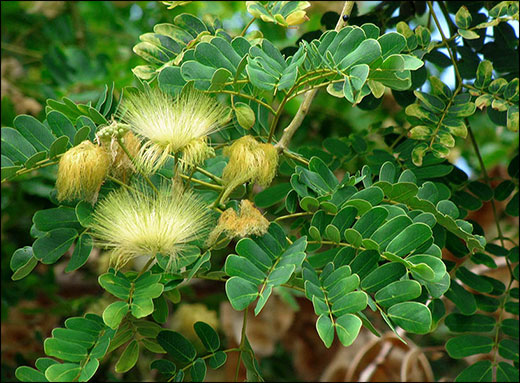Albizia Lebbeck Benth: Unveiling the Majestic Shirish Tree
Abstract
Albizia lebbeck B. is a kind of tree, often called the Shirish tree or Frywood. It is found in parts of Africa, Asia, and Australia. Due to the unique tree’s wide range of applications and ecological significance, it has a special place in traditional medicine, forestry, agriculture, and many more. Some Ayurvedic practitioners have also utilised Albizia lebbeck(Shirish tree) with effectiveness for Svasa & Kasa (Respiratory disorders), Raktapitta (Haemoptysis), Jvara (Fever), Kustha (Skin disorders), and Kamala (Jaundice). Albizia lebbeck(Shirish tree) became endangered due to rising demand due to its many uses. Shirish, an Ayurvedic anti-poison herb, is considered as the most effective antidote to a variety of poisons having both animal and plant origin. The antibacterial and immune-modulating characteristics of this herb have been demonstrated through tests. Let’s have a detailed look at Shirish!

Introduction
Albizia lebbeck, also known as Shirish in Sanskrit, is a plant that can be found all over India, from the Himalayas to the Andaman Islands. The outer layer of the bark is hard, dark brown to greenish black in colour, and has longitudinal and transverse fissures. The inner layer is whitish and has fine vertical stations. The heartwood is dark brown with dark and white streaks, while the sapwood is white or yellowish white, globose heads with greenish yellow flowers. April to June is the beginning of the flowering and fruiting season.
Synonyms
- Shukapirya – Flower resemble bird beak.
- Marudu Pushpa – Flowers are soft
- Mandila – useful in many disease like shwasa.
- Kapitana – Flowers are yellowish in colour.
Vernacular Names
| Botanical Name | Albizia Lebbeck |
| Family | Mimosoideae, Fabaceae |
| Hindi name | Shirish / siris |
| Sanskrit name | Shukriya, kapitana, Bhandira, Marudupushpa, Bhandi |
| English name | Lebbeck tree, Flea tree, Frywood, Woman’s Tongue tree |
| Telugu name | Dirisena Chettu |
| Tamil name | Vaagai |
| Kannada name | Bage Mara |
| Punjabi name | Siri, shari |
| Gujarati name | Sarsado |
| Bengali name | Sirosh |
| Marathi name | Siras |
| Malayalam name | Nenmenivaga |
Geographical Distribution
- It can be found in semi-evergreen vine forests (monsoon woods), Semi-deciduous microphyll vine thickets on quartz sandstone mountain screes, and areas with very dry winters.
- Albizia lebbeck, often known as Shirish, is one of the world’s most common and widespread Albizia species. It is widely distributed in all of India’s provinces, as well as in other regions of south-east Asia and northern Australia. This herb can be found in the Himalayan subrange up to a height of 3800 feet.
Cultivation
The seed is manually collected. As with many legumes, seed can be harvested before the pods dry. Pods are mature when they have turned light yellow and should be harvested after the remaining areas of green have faded. Insects can quickly infest ripe pods if collection is delayed. The pods should next be dried until they rattle and become brittle (ideally in the sun, but protected from seed-destroying beetles).
Soil
It grows well in fertile soil, but not so well in heavy clays. Tolerate acidity, alkalinity, degraded, and waterlogged soils. It occurs naturally on soils overlying basalts, as well as on breakaway slopes among sandstone boulders and basalt outcrops. However, it is not suitable for heavy clay or waterlogged soil.
Climate
Albizia lebbeck is a dominating plant in semi-evergreen vine forests (monsoon forest) with a mean annual rainfall of 1300-1500 mm. It can withstand long hot dry seasons as well as harsh winters. Droughts and frost are tolerable after the first year. Average yearly temperature = 19-35 degrees Celsius.
Temperature
It is found up to 1600 m in its natural environment in Himalayan valleys, but has grown successfully as high as 2150 m where the 24 annual average temperature is 18.7 degrees Celsius. Frost kills the tops of new plants, but plants coppice up from the root once warm weather arrives.
Morphology
- Habitat – tree is big and tall and has a height of 17 to 20 metres. These trees are planted on both sides of the roads.
- The root system is tap root and it goes much deeper inside the earth.
- The bark is pale, fissured, and the new branches are hairless.
- Stem – Cylindrical, woody, and has branching.
- Leaves are compound, unctuous and hairy.
- Leaflet – wide and 4-8 pairs.
- Flower – white, fragrant and tender.
- Legume – 15 to 30 cm long, 1.5 to 3 cm wide, flat tough and contain 6 to 10 seeds, which rattle when dried.
- Seed – brown in colour flat and circular.
Flowering season is monsoon and fruits come in spring (legume).
Taxonomy
- Scientific name – Albizia Lebbeck Benth
- Kingdom – Plantae
- Division – Mangoliophyta (flowering plants)
- Class – Magnoliopsida (Dicotyledons)
- Order – Fabeles
- Family – Fabaceae
- Genus – Albizia Durazz
- Species – Albizia lebbeck
- Clade – Memosoid clade
Phytoconsituents
Bark
- Saponins
- Tannins
- Acid isomers
- Gums and other substances
Plants
- Melacacidin
- Sitosterol
- D-catechin
- Betulinic acid
Roots
- Lupeol
- Stigmasterol
- Trans-p-coumaric acid
- Saponin
Heart wood
- Phenols
- Tannins
- Flavonoids
- Proteins
- Carbohydrates
- Glycoside
Leaves
- Flavonoids
- Tannins
- Saponins
- Unsaturated carboxylic acid carbohydrates
- Alkaloids
- Alcohols
- Phenols
- Ketones
Flowers
- Triterpenes
- Saponin glycosides
- Tannins
- Flavonoids
- Alkaloids
Pod
- Alkaloids
- Carbohydrates
- Saponins and
- Glycosides
- Flavonoids
- Tannins
- Proteins
- Oils and fats
Seeds
- Calcium
- Ascorbic acid
- Phosphorus
- Iron
- Amino acids
- Protein
Pharmacological Properties
- Rasa – Kshaya (Astringent), Madhura (Sweet), tikta (Bitter).
- Guna – laghu (Light), ruksha (Dryness), tikshna (Sharp).
- Virya – Anushna.
- Vipaka – katu (Pungent).
- Dosha action – Tridosha Shamak (Tridosha pacifier).
Classical Categorization
- Charak samhita –Vishaghna, Vedana sthapana, Shiro Virechana, Kashaya Skanda.
- Sushruta Samhita –Salsaradi Gana
- Vagbhata – Asanadi Gana.
- Amarkosh – Vanausadhi Varga
- Ashtanga Nighantu – Asandi Varga
- Dhanwantri Nighantu – Amaradi Varga.
Ancient Verses
Shloka 1
शिरीषो मधुरोऽनुष्णस्तिक्तश्च तुवरो लघुः |
दोषशोथविसर्पघ्नः कासव्रणविषापहः||
(Bhavprakash Nighantu वटादिवर्ग 14)
Interpretation of Shloka
Shirish (albizia lebbeck) is full of Madhur(sweet), Tikta (bitter), Kshaya (astringent) rasa and little ushna (hot potency) and removes Vata-aadi dosha, Shotha (inflammation), Visarpa (Erysipelas) , Kasa (cough), Vrana (ulcers) and Poison.
Action On Different System
1. External Application
Applying seed paste externally offers anti-inflammatory, analgesic, anti-poison, and complexion-improving effects. Seed paste is used on the skin to improve complexion and is helpful for the eyes and Nasya. For tooth decay, a decoction is gargled. As eye drops for eye diseases, leaf juice is employed. Anjana is also made from seed powder. In many poisonous situations, it is really helpful.
2. Internal Use
- Digestive system – Astringents at high amounts produce vomiting. The use of bark powder strengthens the gums.
- Respiratory System – Kaphghna and Shirovirechna (Nasya) are used to treat rhinitis cough, and breathing problems, among other things. Powdered seeds Nasya is indicated for pradhaman Nasya (nasal administration) in kapha diseases. Asthmatics can be treated with flower juice, pippali powder (piper longum), and honey. The aroma of flowers alleviates migraine headaches. In such cases, Leha made from it is also beneficial.
- Circulatory system – Purifies the blood and is anti-inflammatory, making it effective in blood disease, inflammation, herpes, and lymphadenopathy. Bark and seed churna are used to treat these conditions.
- Skin – Indicated in skin disorder.
- Reproductive system – It has a virilizing effect. For virilization, seed powder mixed with milk is administered to poor-quality sperm. Flowers are used to postpone ejaculation. In puberty, delayed menstruation is treated with milk-infused flowers.
Therapeutic Uses
- Eczema (Pama)
- Coryza (Pratishyaya)
- Snake bit (sarpadansa)
- Disease of skin (Kustha)
- Cough (Kasa)
- Asthma (shwasa)
- Itching (Kandu)
- Inflammation (Shotha)
- Conjunctivitis (Netrabhiasanda)
- Erysipelas (visarpa)
- Rat poisoning (musaka vish)
- Chronic rhinitis (pinasa)
- Ulcer(vrana)
- Urticaria (sita pitta)
- Worm infestation (Krimi Roga)
- Vitiation of blood and its components (Rakta dushti)
- Migraine (ardhvabhedaka)
- Disorder due to poison (Vishadusti)
- Intermittent fever (Visamajvara)
- Sinusitis (suryavarta)
Side Effects
- Sleepiness
Effects On Dosha
Vata, Pitta, and Kapha, Balances all tridoshas.
According To Brihatri
Pharmacological Properties Of Shirish In Different Dosage
1. Charaka Samhita
| Sr.No. | Part Used | Dosage form | Disease |
|---|---|---|---|
| 1. | Beeja (Seed) | Shiro virechana (Nasya), Nasya/Anjana, Pra lepa | Shiraha shoola, Ardhavabhedaka, Kushtha, Unmada, Arsha, Shiro roga, Luta Visha |
| 2. | Twak (bark) | Lepa, Siddharthakadi yoga (lepa), Amrit Ghrita, Mula Taila | Visha, Visrpa, Kustha, Unmada, Shwasa, Kasa, Pliha Roga |
| 3. | Puspa (flower) | Lepa, Swarasa (Nasya), Nasya/pana/anjana | Visarpa, Visha, Shwasa, Hikka |
| 4. | Phala (fruit) | Lepa, Nasya/pana/lepa | Medhaka visha, Visha |
| 5. | Panchanga (whole plant) | Maha Gandhahasti agad, pana/lepa | Visha |
| 6. | Parta (leaf) | Swarasa (nasya) | Visha |
| 7. | Sara (heart wood) | Asava, Maha Kashaya, Churna, Kwatha | Vedana Sthapana, Vishaghna, Kikkisa, Dadru, Pittaja Prameha |
2. Sushruta Samhita
| Sr.No. | Part Used | Dosage form | Disease |
|---|---|---|---|
| 1. | Beeja (Seed) | Pratisarana, Churna | Visha, Netra Vikara |
| 2. | Puspa (flower) | Banshagatwadi agada (lepa, nasya), Anjana | Luta visha, Netra Vikara |
| 3. | Phala (fruit) | Churna, Lepa, Shiro virechana | Avasadana, Arsha |
| 4. | Panchanga (whole plant) | Lepa, Kwatha, Ghrita, Dhanwantri Ghrita, Maha vajrak Taila, vajrak Taila, Yavagu | Dadru Nashaka, Shirah shoola, Visha, Hasti meha, Pittaja ashmari, Prameha Pidaka, Kushtha, Nadi vrana, Visha |
3. Astanga Hridaya
| Sr.No. | Part Used | Dosage form | Disease |
|---|---|---|---|
| 1. | Beeja (Seed) | Lepa, Mukha Lepa | Arsha, Vyanga |
| 2. | Puspa (flower) | Swarasa, Anjana | Shwasa, Netra vikara |
| 3. | Twak (bark) | Lepa, vajrak Taila | Kushta |
| 4. | Parta (leaf) | Swarasa, Ghrita, Swedana | Shirah Shoola, Ashmari |
Home Remedies Of Shirish (Albizia Lebbeck)
1. Non-healing ulcers
Bark powder dusting on non-healing ulcers
The dried bark is pounded into a fine powder. It is applied as a powder to the ulcers.
2. Herpes
Apply bark or leaf paste to herpes or high pitta skin condition.
Fresh bark or leaf is gathered and grind into a fine paste. This is administered to skin lesions such as herpes or blisters that cause burning and itching.
3. Sexual debility
Seed powder with milk for sexual debility
The dried seeds are taken made into fine powder. This is mixed with or boiled with milk or boiled with milk. This improves sex power and stamina.
4. Dental care
Because of its antibacterial properties, Ayurvedic Kshaya (decoction) of its bark is used as a gargle to cleanse the buccal cavity. Shirish stem has been used to wash teeth since ancient times.
5. In poisoning
Aak (Calotropis procera latex) topical application of paste formed from Shirish (Albizia lebbeck) seed and Pippali (Piper longum) powder erosion is useful in snakebite, spider sting, bug poisoning, rat poisoning, and scorpion sting.
6. In unmada
In equal quantity mix ginger, Ashwagandha, Mulethi, Vacha or Sharish seeds powder and take them in morning and evening 1 tbsp. This will be beneficial for Apasmara (epilepsy) and Unmada (insanity).
7. In visarpa (erysipelas)
In erysipelas, a topical application of a paste or powder made from equal parts Amaltas (Cassia fistula) leaves, Lasoda (Cordia myxa) bark, and Shirish (Albizia lebbeck) flower is beneficial.
8. In eyes
To prevent seasonal eye allergies, night blindness, and excessive lacrimation, 2 drops of Shirish fresh leaf juice are inserted into each eye.
9. In ear pain
Heat the sharish leaves slightly and squeeze them to extract the juice. Put that juice in the ear because it will provide relief from pain.
10. In cough
Fry old yellow Sharish leaves in ghee on low flame and then add some honey to it and consume. This will provide relief from cough.
11. In diarrhoea
Grind and consume half a gram of sharish seeds. This will provide relief from diarrhoea.
12. In liver and ascites
Cook 10 grams of Shirish bark in 200 grams of water and then 50 grams of water is left to use. This ascites and liver problem will get relief and also relief in liver infection. This increases the amount of urine and poisons or toxins will be removed from the body.
13. In eczema and psoriasis
In this, dry the leaves of Shirish, crush them, tie them in clay pots and burn them all around. Then mix its ashes with cow’s ghee or mustard oil and apply it on the skin disease area. This will provide relief from skin diseases. This is very beneficial for Psoriasis.
14. Nasal allergies
To avoid seasonal nasal allergy or sinusitis, 2 to 4 drops of Shirish fresh leaf juice are placed in each nostril.
15. Headache
In migraine, a fine paste of Shirish flower is applied to the forehead.
Ayurvedic Products From Mandukaparni
Part Used
Bark, Leaf, Seed, Flower
Dose
- Churna – 3-6 gm
- Water decoction – 50-100 ml
- Fresh Juice – 10-20 ml
Conclusion
Albizia lebbeck has been traditionally used in the cure of various diseases. It contains a large number of alkaloids, flavonoids, tannin, and saponin. For this reason, ancient Aacharyas referred to it as the Vishaghna plant. Shirish was named by Acharya Charaka in Vishaghana Gana Dravyas (anti-poisonous drugs) as one of the best anti-poisonous drugs. Numerous research showing the drug’s antibacterial, analgesic, anti-inflammatory, anti-diarrheal, immuno-modulatory, antiarthritic, antioxidant etc. activities have been undertaken by various various portions of the plant. This makes it appear like a viable medicine for a variety of uses. Various forms of yoga with Shirish as an element have been recorded for both internal and external application in all Samhitas.





